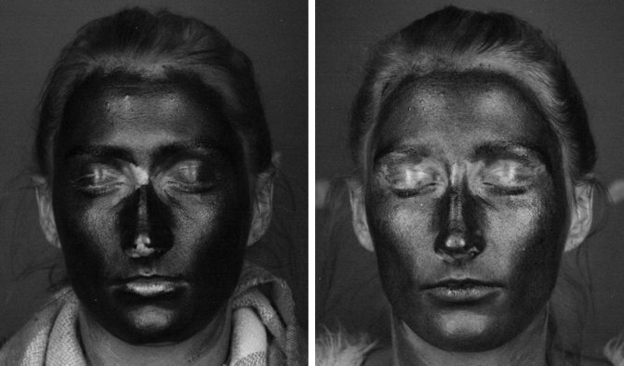
SPF 30 sunscreen (left) SPF 30 Moisturiser (right)
University of Liverpool research, published in PLOS One, shows moisturisers with sun protection factor (SPF) provide less sun protection than the equivalent strength sunscreen in real-world scenarios, and people are more likely to miss areas of their face when using them.
Prolonged or excessive exposure to sunlight causes skin damage in the form of sunburn, premature ageing and increased risk of skin cancers. For these reasons there is a broad push to use SPF containing creams or sprays to protect ourselves from the worst of this damage.
Traditionally these sunscreens have been specially designed formulations, however, more recently, daily moisturisers, makeups and a variety of other skin care products have started to include sun protective elements. Despite the popularity of these products their effectiveness has not been rigorously tested.
Using a specially modified camera that only sees UV light the researchers from the University’s Department of Eye and Vision Science, led by Dr Kevin Hamill and Mr Austin McCormick, assessed how effectively people apply sunscreen and sun protection factor (SPF) containing moisturiser to their face. When an area of skin is successfully covered, the product absorbs the UV light and this area appears black in the photos – the lighter the area the less successful the absorption.
Moisturiser not applied as thickly
Over two separate visits, 84 people (21 men and 62 women aged 18-57) were asked to apply sun protection, in the first visit SPF30 sunscreen, and in the second moisturiser with SPF30, or vice versa. Pictures were then taken with the modified camera to see how effectively people applied the two products.
Analysis of the photos showed that when applying moisturiser people missed 17 per cent of their face on average, whereas when applying sunscreen this dropped to 11 per cent. When just the high-risk eyelid areas were analysed sunscreen users missed 14 per cent compared with 21 per cent with moisturiser. The eyelid area is a common site for skin cancers.
In addition to this, the study suggests that people do not apply the moisturiser as thickly as sunscreen, and therefore do not receive the full benefits of the SPF. The photos of people using the moisturiser are noticeably less dark on average, this indicates that the product is absorbing less UV light.
On average men were significantly better at applying the products than women, other groups that proved better at it were people with darker skin tones and older participants.
Participants were asked to rate their perceived ability to apply the products before and after viewing the images. For sunscreen, perceived ability dropped from 90 per cent positive to 42 per cent, and moisturiser from 85 per cent to 38 per cent, indicating that participants were not aware of their failure to achieve adequate coverage.
Overall protection
Mr Austin McCormick, Consultant Ophthalmic and Oculoplastic Surgeon, and one of the researchers, said: “When applying both sunscreen and moisturiser, the area around to eyes is often missed, particularly near the nose. Participants covered a smaller area of the face when using moisturiser compared to sunscreen. We conclude that particular attention should be paid to the eyelid area when applying any SPF cream.
“Alternative methods of protecting the eyelids should be considered such as UV filter sunglasses. Moisturiser is not as well applied as sunscreen therefore if planning prolonged sun exposure we advise sunscreen be used. if using moisturiser we advise one with SPF: any SPF is better than none but it should not be considered the equal of sunscreen.”
Dr Kevin Hamill, Lecturer in Cell and Molecular Biology at the University’s Department of Eye and Vision Science, said: “One of the things I particularly enjoyed about this research is that it’s very visual and fairly easy for people to understand. The darker the image, the more sun protection people are getting. “Although moisturiser with SPF does provide sun protection, our research suggests that it’s not on the same level as sunscreen. We would not recommend it as a like-for-like replacement for your sun protection needs.”
The researchers believe alternative sun-protection strategies should be promoted and a more extensive public awareness campaign is warranted.
The full study, entitled ‘Application of SPF moisturisers is inferior to sunscreens in coverage of facial and eyelid regions‘, can be found here.